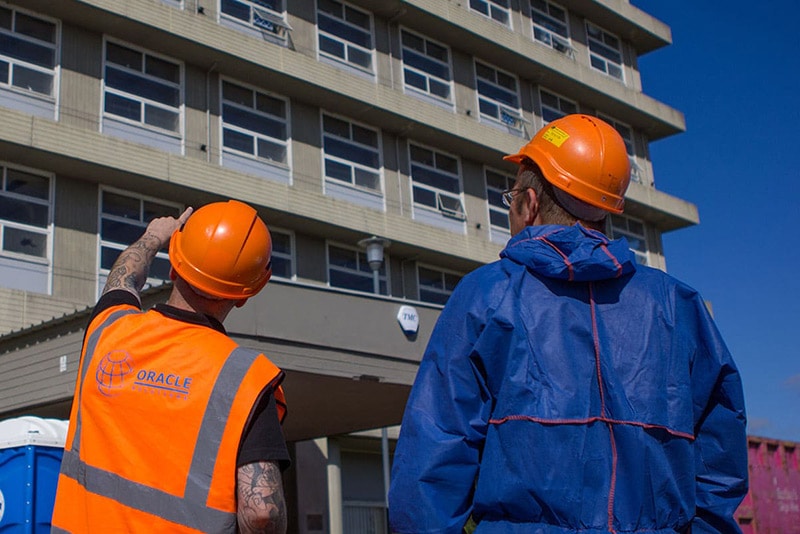Is there guidance for loss adjusters and insurers regarding asbestos?
With loss adjusters being professionals that insurance companies appoint in order to investigate and assess insurance claims, they undoubtedly play a critical role in such firms’ handling of a broad variety of claims.
An insurance claim may, after all, be made in response to such insured events or “perils” as fire, flood, storm, subsidence, or the escape of water. Such occurrences can cause damage to a policyholder’s building, the building’s contents, or both. The extent of the damage, too, can vary hugely, from minor damage through to the catastrophic loss of the entire building and its contents.
Insurers and loss adjusters, then, inevitably have to deal with various complex issues and situations when claims are made to them.
Given not only the very real health risks that can be easily presented by disturbed asbestos-containing materials (ACMs) if one or more of the above “perils” comes to pass, but also the stringent legislation surrounding asbestos in the UK, it is crucial for insurers to be aware of asbestos in their property claims handling.
So, let’s take a look at some of the fundamentally important things for insurers and loss adjusters to know in relation to the sensitive and specialised topic of asbestos.
What are the initial steps insurers take when a property claim involving asbestos is reported?
The first contact between the customer and the insurer or broker, which usually happens over the phone, is known as the “First Notification of Loss” (FNOL) stage. This is when the call centre worker representing the insurer will need to take basic details of the damage and the repair costs, where this information is known.
Call handlers will then route the claim based on the information that the customer has provided – including whether asbestos is said to be present in the area of damage. An insurer may use a “scoping tool” (computer software), together with the policyholder-supplied information, to calculate cash settlement.
In the event of the policyholder stating at the FNOL stage that asbestos is present, and the insurer arranging an inspection of the affected site, the business will need to appoint a competent individual to undertake this process.
Once appointed, this representative of the insurer should undertake a pre-visit risk assessment. This may be carried out on the phone with the customer, on the doorstep prior to entering the property, or a combination of both.
Such initial steps will help ensure that any relevant ACMs are identified as early as possible in the claims process. This, in turn, will allow for informed decisions to be taken to ensure both legal compliance and the highest standards of safety.
How should loss adjusters approach properties with suspected asbestos?
If the person that the insurer is looking to appoint to inspect the damage will only attend the site in order to identify the risk, it should be sufficient for that individual to have received asbestos awareness training. In situations, however, where the individual’s duties will include disturbance of the ACMs, there will be a need for more in-depth asbestos training.
Where an insurer appoints a contractor, the insurer must satisfy itself that the contractor is competent to undertake this work. The insurer must make reasonable inquiries, and carry out due diligence in the selection process, including asking asbestos-specific questions, followed by an audit.
The pre-visit risk assessment should include – presuming the property being inspected is a commercial one – the insurer’s representative requesting a copy of the property’s asbestos management plan, if available.
It will also be necessary for the pre-visit risk assessment to take into account the age of the building (asbestos having only been legal to use in the UK until 1999), whether the property has been altered or extended, and whether ACMs are likely to be present.
In the case of commercial premises, the asbestos survey – which is a legal requirement for such buildings – should also be requested and reviewed by the insurer representative before they enter the building, or as soon as possible while the visit is taking place. Whether the building is a residential or a commercial one, a “suitable and sufficient” risk assessment will need to be carried out before work begins.
Inspection and checking will only be needed in areas where access is required, and where repairs related to the claim are to be carried out (in other words, not the entire building, if other parts of the property are unaffected).
If the loss adjuster or contractor is convinced that there is a possible risk of ACMs being present in the damaged area of the building, the immediate advice should be to isolate and vacate the affected areas, until it is confirmed whether ACMs are, indeed, present.
Where the inspection indicates that ACMs may have been disturbed as a consequence of damage, or may need to be disturbed during repair work, it is essential to arrange for an asbestos test. This will be crucial for confirming whether asbestos is present in the damaged area.
How do insurers and loss adjusters ensure compliance with asbestos legislation?
With the Control of Asbestos Regulations 2012 (CAR 2012) serving as the overarching asbestos legislation in the UK, it is of the utmost importance for insurers, loss adjusters, and contractors to take every possible measure to ensure compliance with these regulations.
The key requirements under the UK’s present asbestos and associated legislation include, but are not limited to:
- Contractors always carrying out a risk assessment before work begins to identify ACMs
- Appropriate work methods being selected to help reduce asbestos risks
- Licensable asbestos work only being carried out by a contractor that holds a licence from the Health and Safety Executive (HSE)
- Any licensed asbestos work being notified to the HSE in writing at least 14 days prior to the work commencing
- Workers being given appropriate information, instruction, and training to enable them to undertake the asbestos work in a safe manner
More detailed information on the steps that must be taken to ensure compliance with UK asbestos and health and safety law can be found on the HSE website, and in free-to-download publications such as the L143 Approved Code of Practice (ACOP) and guidance document, Managing and working with asbestos.
It should be noted that health and safety legislation in the UK is concerned with the manner in which asbestos repair work is carried out, rather than the contractual obligations that insurers have arising from the initial insured event.
How are claims adjusted when asbestos is involved in property damage?
It is crucial for the loss adjuster or contractor to have undergone appropriate training enabling them to not only identify potential ACMs, but also identify where such materials have sustained damage and identify where they may be disturbed during any subsequent repairs.
If potential ACMs are, indeed, identified, the validation of loss will need to include the cost of any required asbestos tests. If it will be necessary to encapsulate or remove and dispose of ACMs in relation to insured damage, validation should include the reasonable cost of such work, including arrangements to have licensed contractors carry out the work if necessary.
The given insurance policy may, or may not, provide cover for alternative accommodation in situations where asbestos contamination requires the occupant to vacate the property. Whether this is the case is a matter between the insurer and the policyholder, as it is a contractual matter unconnected to health and safety legislation.
As a general rule, alternative accommodation probably won’t be necessary – and therefore won’t be covered by insurance – in cases where the damage can be isolated within the property and continues to be undisturbed. Where ACMs are confirmed to be present, the affected room or area should be isolated, with the customer being informed and advised against any disturbance of the material.
What are the implications of asbestos findings during post-claim repairs?
In situations where repair work is being carried out at a property following an insurance claim, and previously unidentified ACMs are discovered, work should come to a halt while a further risk assessment is carried out.
At this stage, it will need to be considered whether changes should be made to how the repair work is undertaken, as well as whether licensed contractors will now need to be appointed, and whether the HSE will need to be notified of such work.
This reassessment process – which must be recorded – along with the sensible adjustment of any repair strategies at the site, will be critical to ensuring continued safety and legal compliance.
Conclusion: insurers and loss adjusters must be well-educated on asbestos risks
Hopefully, the above guidance will have left you in no doubt about the importance of strict adherence to guidelines and regulations for managing asbestos in property claims.
Ongoing education and awareness among insurers and loss adjusters regarding asbestos risks should be high priorities, in light of the wide range of UK public, residential, and commercial buildings that still contain asbestos even in the 2020s.
For further advice on legal obligations and safety measures in relation to asbestos, and to receive a quote for any of our own licensed and accredited asbestos services here at Oracle Solutions, please don’t hesitate to contact us.

Written by Brendan Coleman
Brendan Coleman, with decades of experience in the asbestos industry, is a dedicated Quality Manager. Certified as a surveyor and analyst, he is adept in operations and quality management with a keen focus on HSE compliance. His expertise is pivotal in maintaining high safety and efficiency standards. Brendan ensures our UKAS accreditation requirements are consistently met and exceeded, upholding stringent standards in asbestos remediation. His commitment to enhancing quality and customer satisfaction makes him an essential advisor in asbestos management.

